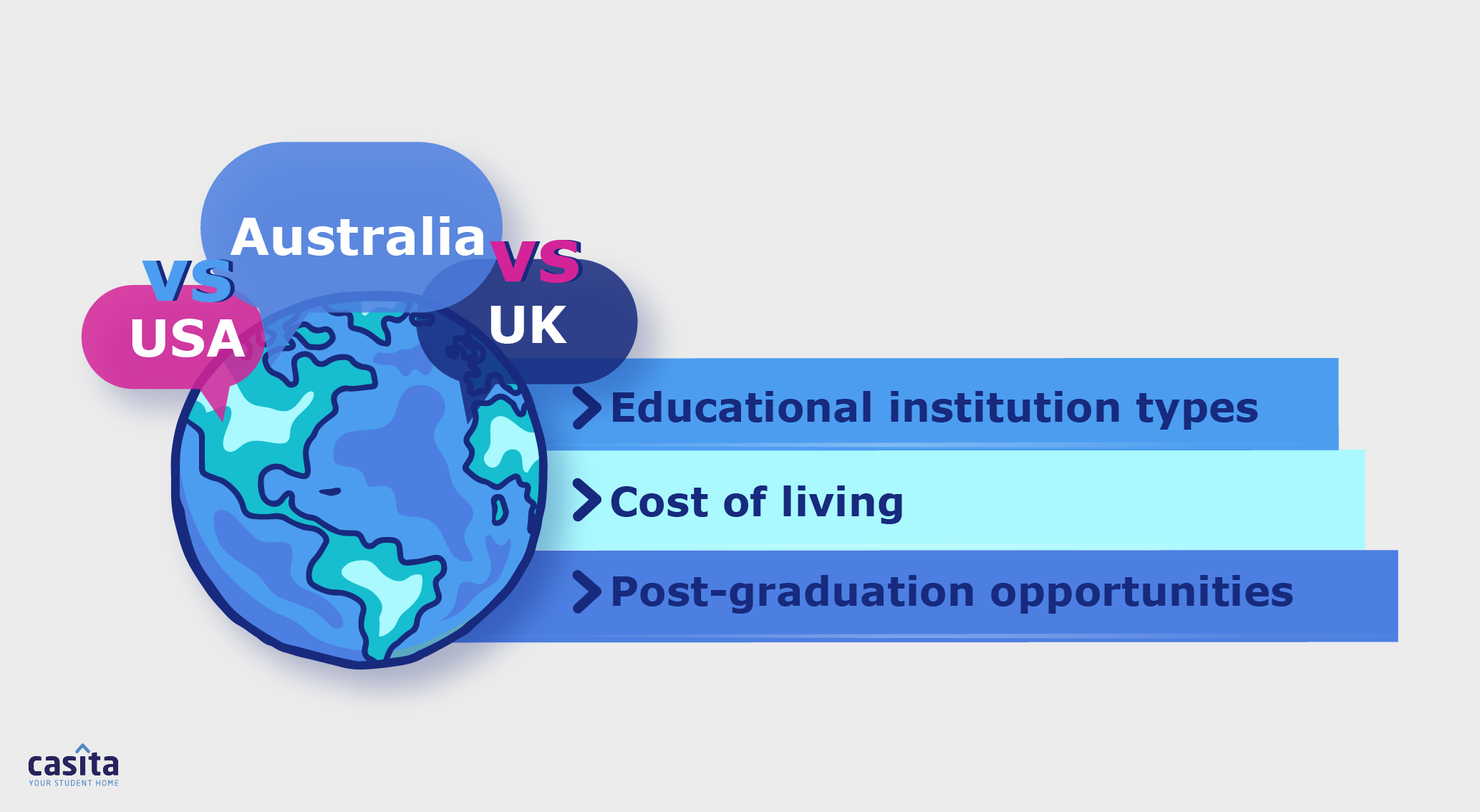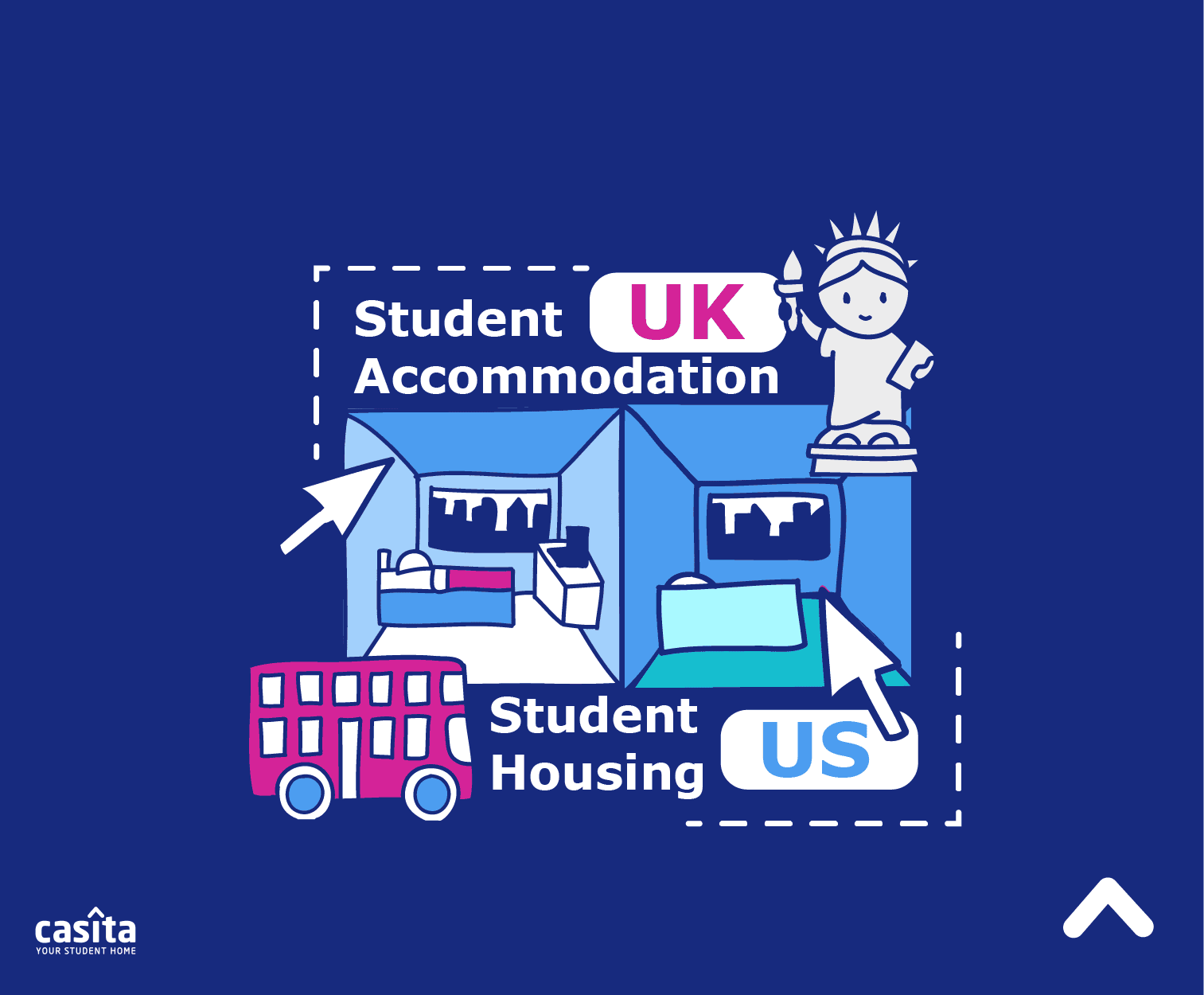UK vs USA vs Australia: Where Should You Study Abroad?
University Life
Travel Preparation
Exploring
10 mins read
Share

Updated at: 21 December, 2025
Published at: 22 August, 2020
By Samir Badawy
UK vs USA vs Australia: Where Should You Study Abroad?
University Life
Travel Preparation
Exploring
10 mins read

Updated at: 21 December, 2025
Published at: 22 August, 2020
By Samir Badawy
Share
Suppose you have the choice to study in the UK, the USA, or Australia. In that case, the decision can get complicated as these three destinations are renowned for their high quality of education and high quality of life.
So, if you have the opportunity to study in any of these three countries and need to make up your mind about where to study, we’ll help you make a more independent decision by comparing the USA vs Australia vs UK in terms of education, cost of living, quality of life, post-graduation opportunities, and more.
Education in the USA vs Australia vs the UK
According to the World Grad, the USA, UK, and Australia are among the educational destinations, with the USA ranking first, the UK ranking second, and Australia ranking third in 2025.
Education in the USA
The U.S. higher education system is known for its flexibility, where various students can start undeclared and choose their majors later. The USA has nearly 4,000 institutions, and the U.S. offers a wide range of programs and study options.
The USA also has some of the highest-ranked higher education institutions, which include the Massachusetts Institute of Technology (MIT), which ranks first worldwide, Stanford University, which ranks third worldwide, and Harvard University, which ranks fifth worldwide, all ranked according to the QS world university rankings of 2026.
In the U.S., undergraduate students are usually required to take a combination of core or general education courses, major-related subjects, and elective courses. Core or general education subjects cover writing, mathematics, sciences, and social sciences, while electives allow students to explore interests beyond their main field of study.
The academic year is divided into two main semesters, each lasting around 15 to 18 weeks, including final exams. According to Times Higher Education, the cost of studying in the U.S. can range from about $5,000 to $50,000 per year, depending on the type of institution and program.
Institution Types
Universities
Public Institutions
Public institutions are state-funded universities, typically larger than private institutions, and have a relatively lower cost than private institutions. Public universities are often the most affordable options for national students. However, international students will be required to pay higher fees.
Private Institutions
Private institutions are smaller than public ones and are made with the goal of educating while also making a profit. Among their primary revenue streams are tuition fees, and they may also rely on donations. Unlike public universities, these institutions aren’t funded by the public, hence the higher costs.
Private universities, however, try to offer equal opportunities through grants and scholarships. Another type of private institution is “Non-profit private universities”. These aim to build a strong reputation and provide excellent education rather than generating money.
Research Universities
Research universities spend vast amounts of money on research-related activities and often produce high-quality research. Research universities often provide doctorate degrees and include all Ivy League Schools, which are among the top universities in the USA, mainly in the Northeast.
Colleges in the USA
Community colleges
These are usually lower-level post-secondary institutions and primarily grant diplomas, certificates, and associate degrees. Education at community colleges lasts for two years. Community colleges are more affordable than private colleges as they are publicly funded.
Liberal Arts
Liberal arts colleges typically focus on the Liberal Arts (humanities, social sciences, sciences). These colleges are small in size, are mainly non-profit and private, and focus on undergraduate education levels.
Other College Types
There are many other college types in the USA, such as specialised colleges, religious colleges, for-profit colleges, and art colleges.
Most Popular Majors in the USA
According to data compiled by the NCES between the years 2020 to 2021, the most popular majors in the USA out of 2.1 million Bachelor degrees were found to be the following:
Business: 19 per cent of all bachelor's degrees
Health Professions and related programs: 13 per cent of all bachelor's degrees
Social Sciences and History: Eight per cent of all bachelor's degrees
Biological and Biomedical Sciences: Six per cent of all bachelor's degrees
Psychology: Six per cent of all bachelor's degrees
Engineering: Six per cent of all bachelor's degrees

Education in the UK
The United Kingdom’s education system is known for its world-class quality and ranks among the top worldwide, with some UK universities ranking among the top ten, such as the University of Cambridge, which ranks second worldwide, the University of Oxford, which ranks fourth worldwide, and Imperial College London, which ranks sixth worldwide.
The Higher education system in the UK focuses on theory and focused on enhancing the student’s understanding of the subject; the courses are also shorter and more focused, and the study span is also shorter when comparing the USA vs the UK, as you can graduate in three years in a bachelor’s program as opposed to four years.
Regarding master’s programs, you can finish your master’s in a year in the UK rather than two years as opposed to the USA, all without affecting the quality of education. Education in Scotland, Wales, and Northern Ireland is similar to England, with some minor differences. You can get more details about the UK Grading System by following this link.
The cost of studying in the UK ranges anywhere from £11,400 to £38,000 per year for undergraduate studies and £9,000 to £30,000 per year for postgraduate studies.
Institution types
The UK’s institution types mainly vary based on whether they are degree-awarding or non-degree-awarding institutions. Degree-awarding institutions provide bachelor’s, master’s, and doctoral degrees. In contrast, non-degree awarding institutions provide you with certificates to get into the job rather than developing a skill; these include vocational schools and colleges.
Universities
Ancient Universities
Ancient universities were established between 1096 to 1582; these include universities such as the 1096-established University of Oxford. These universities enjoy architectural distinctiveness and tend to focus on complex theoretical subjects, and they enjoy a strong reputation.
Red Brick Universities
These universities focus on real-world skills as they were demanded during the First World War. The subjects typically revolve around technology, science, design, and engineering. These universities were built during the 1900s and are very inclusive, making them attractive to international students. The University of Birmingham, built in 1900, is among the UK’s Red Brick universities.
Plate Glass Universities
Plate Glass universities have been dubbed so because of their distinct architectural style, which is similar to US campuses; these universities were built between 1963 to 1992 and have been progressive as they experimented with new teaching techniques and methods and were regarded as progressive. Lancaster University is an example of a Plate Glass university established in 1964.
New or Metropolitan Universities
These universities started as various other higher education institutions, such as further education colleges and training colleges, among other types of institutions, and have evolved into universities.
Despite their new university statuses, they have a longer history of education. These universities constantly compete with other universities in terms of facilities and modernity. The UK’s education reforms between the 80s and 90s mainly triggered the start of these universities. An example of such a university is the University College Birmingham.
Russel Group Universities
Russel Group Universities are the equivalent of the US IVY league schools. These consist of the top 24 universities in the UK.
Due to their strength in higher education, they receive two-thirds of the government funds allocated to research. They also consist of universities across all the previously mentioned classifications. One such university is the University of Cambridge.
Further Education
The UK also has a further education system, which consists of any study done after secondary education and isn’t part of higher education. This system, also referred to as FE, awards three levels of qualifications, the first being the “general qualification” level that enables you to keep progressing into a higher level and sets the foundation, the next level being level two, which either allows you to progress to work or another tech level and the third level allows you to specialise in a technical job.
Most Popular Majors in the UK
According to HESA, the UK’s most popular degrees include the following:
Business and Management: 530,460 enrolled students.
Health-related subjects: 366,210 enrolled students.
Social Sciences: 286,325 366,210 enrolled students.
Design, Creative, and Performing Arts: 189,890 enrolled students.
Engineering and Technology: 185,725 enrolled students.
Computing: 164, 260 enrolled students.
Law: 142, 260 enrolled students.
Education in Australia
Education in Australia is similar to the US in that the studying system varies based on the region, leading to various grading systems in Australia. Despite Australia’s regional differences, they have a “Qualifications Framework” that allows students to move across institutions easily.
Australia has 43 higher education institutions, including six among the top 100 worldwide. According to the QS world rankings of 2024, Australia's highest-ranked educational institutions include the University of Melbourne, which ranks 14th worldwide. Australia’s Bachelor’s degrees can take anywhere between three to four years.
Australian Universities have three semesters which include a summer semester. An Australian Academic Year has two semesters which are each approximately five months.
What is special about the Australian higher education system is its student-focused nature. With that said, it relies heavily on feedback from tutors, adapting teaching methods to suit your needs, and providing support. The Australian system also focuses on students getting their own information rather than memorising it. Australian programs also tend to be multi-disciplinary, meaning you’ll learn various subjects, not necessarily all fitting within the same box.
Depending on your study level (Undergraduate or Postgraduate) in Australia, you can pay AUD $20,000 to AUD $50,000 per year on average as an International student.
Institutions
Universities
Similarly to the United States and Australia, Australia also has its own university types; these include the following:
60s and 70s Universities
These universities were established to meet higher education demands at that time and were given a different system than traditional universities. An example of such a university is La Trobe University.
Australian Technology Network
These universities are technologically driven and have a mission to impact the country technologically. The network comprised five universities that started as technical institutes but were disbanded in 1982. An example of such a university is RMIT University.
The Group of Eight
The Group of Eight or Go8 is comparable to the US’s Ivy League Schools and the UK’s Russel Group Universities. These eight universities are the oldest and most prestigious universities in Australia. One such university is the University of Melbourne.
Regional Universities
These include seven universities that all aim to contribute to their affiliated regions. Because of its regional outlook, it focuses on providing high education with accessibility to enhance the various Australian regions and economies. Some of these universities include CQ University Australia.
New Generation Universities
These were initially colleges which offered a higher level of education and later transitioned to universities. These are colleges with advanced education and research. An example of such a university is Bond University.
Vocational Education and Training Institutions
These are also known as VET institutions, which offer non-university programs and focus on technical courses. VET qualifications include six certification levels, with the first level granting you a competent operator career outcome, the second qualification giving you an advanced operator outcome, the third giving you an advanced tradesperson qualification or technician, the fourth giving you a supervisor outcome, the fifth level is a Diploma which allows you to become a para-professional. The last Advanced diploma qualification gives you a Junior manager outcome.
Most Popular Majors in Australia
According to the Australian Government, the most popular majors include the following:
Health care and social assistance: 14% of the working population
STEM (science, technology, engineering & mathematics): projected growth 11.6% until 2024.
Education: 9% of the working population.
Construction and Trades: 9% of the working population.
Cost of Living and Quality of Life in the USA vs Australia vs UK
According to aggregate data, the cost of living in Australia, the USA, and the UK are as follows. Bear in mind that costs may vary depending on lifestyle choices and city.
Item | USA | Australia | UK |
Student Housing |
| AUD $440 to AUD $1,100 per month | £400 to £600 per month |
One-bedroom Apartment (City Centre) | $1,838 on average per month | AUD $2314 per month | £920 on average per month |
One-bedroom Apartment (Outside City Centre) | $1,379 on average per month | AUD $1816 per month | £714 on average per month |
Utilities | $429.33 on average per month | AUD $549 per month | £80 to £140 per month (+TV License) |
Groceries | $400 to $600 per month | AUD $500 to AUD $1000 per month | £464 to £620 per month |
Public Transportation (Monthly Pass) | $45 to $100 per month | AUD $100 to AUD $247 per month | £50 to £173 per month |
You can also read more student-finance-related information in Cost of Living in Australia vs UK, Reduce Your Cost of Living in Australia, and The Best USA Cities for Student Apartments. Everything You Need to Know About UK Utility Bills.
Regarding the quality of life, when comparing the USA vs Australia vs UK, Australia will rank the highest, ranking ninth worldwide, the UK ranks 12th worldwide, and the USA ranks 21st. These are according to US news.
Incomes, on the other hand, differ with the USA ranking fifth worldwide, Australia ranking 11th, and the UK ranking 17th in 2023.
Post-Graduation Opportunities in the USA vs Australia vs UK
Regarding post-graduation, Australia ranks first in offering post-graduation visas, also called a Temporary Graduate Visa, which allows you to stay in the country from two to four years post-graduation, with the length of stay dependent on your degree.
The UK ranks second and gives you a two-year post-study work visa and allows you to stay for two years. You can later switch this Graduate Visa once found employment to become a work Visa.
The US allows you to stay and study after work, however, unlike Australia and the UK, you wouldn’t be given a Graduate Visa but would consist of you switching up your visa type by either applying to an Optional Practical Training where you can stay and work after your graduation for 12 months and later have it extended by applying to a STEM OPT.
The STEM OPT can extend your duration to 24 months rather than 12. Lastly, the H-1B visa can also be an option if you have secured a job and can allow you a stay of up to six years.
The Final Verdict
When making a final decision when comparing the UK vs USA vs Australia, we will find the following, regarding the overall quality of education, the US ranks first, the UK second, and Australia comes after both. All quality of education is among the top worldwide, however, if you’re looking for quality of life and post-work job opportunities, then Australia and the UK will rank higher than the USA.
Regarding living costs, Australia is reportedly more expensive than the USA, and the UK is cheaper than the US. However, what Australia makes in high costs, it makes up for in quality of living and post-graduation opportunities.
University Life
Travel Preparation
Exploring
By Samir Badawy
Share
University Life
Travel Preparation
Exploring
Updated at:
Published at:
By Samir Badawy
Share






